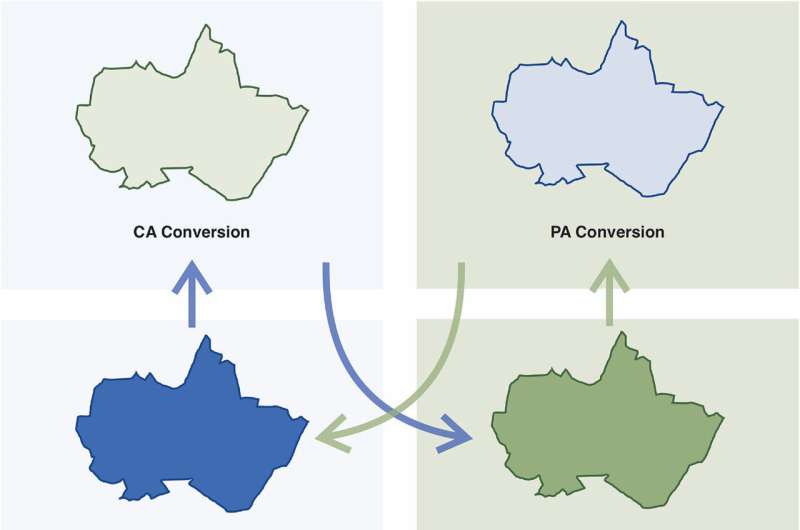This article has been reviewed according to Science X's editorial process and policies. Editors have highlighted the following attributes while ensuring the content's credibility:
fact-checked
peer-reviewed publication
trusted source
proofread
Alarm bells ring as scientists uncover major flaws in ability to track changes to global conservation areas

In a significant stride towards safeguarding global biodiversity, the Kunming-Montreal Global Biodiversity Framework (GBF) has set a target for nations to preserve 30% of the Earth by 2030.
This commitment necessitates an unprecedented expansion of area-based conservation efforts, encompassing both traditional Protected Areas and emerging Conserved Areas or Other Effective area-based Conservation Measures (OECMs).
Associate Professor Carly Cook from the Monash University School of Biological Sciences and an international team of researchers have identified a method to carefully monitor changes in Conserved Areas. The process is outlined in a study led by Associate Professor Cook and published in One Earth.
"There are still important questions about how Conserved Areas will work alongside traditional Protected Areas and how effective they are at protecting nature," said Associate Professor Cook.
"Recent discoveries show that there are major gaps in how we keep track of changes to Conserved Areas."
The critical distinction between a Protected Area and a Conserved Area lies in their management objectives: while a Protected Area is exclusively designated for conservation purposes, a Conserved Area allows for a broader range of management goals as long as it effectively preserves biodiversity in its natural habitat.
Conserved Areas foster biodiversity conservation outside Protected Areas but there is no requirement for equivalent legal protection for biodiversity.
The method identified in this most recent study allows scientists to analyze the size and how much protection an area receives, similar to what is done for Protected Areas.
Using this process, the researchers found a major case where protection was taken away from a Conserved Area in Canada.
"This change allowed oil and gas exploration in a place called the Northeast Newfoundland Slope Closure, which is very important for the conservation of rare cold-water corals," said research collaborator Associate Professor Chris Lemieux from Wilfred Laurier University in Canada.
"The research also shows how important it is to have clear methods of observing changes made to both Protected and Conserved Areas," Associate Professor Cook said.
"And until now, we haven't had the tools to do this. Surprisingly, our study also found hundreds of cases where Protected Areas were turned into Conserved Areas without clear records or reasons.
"These changes made up about 42% of all Conserved Areas, highlighting that many countries were not adding new areas to the conservation estate but instead converting existing Protected Areas."
Associate Professor Cook called for urgent changes to how Protected and Conserved Areas are tracked going forward.
"We need to make sure changes advance protections for both types of areas and help meet our goals for protecting nature," she said.
"Having clear ways to monitor changes in Protected and Conserved Areas is critical to understanding whether the world is meeting its global conservation targets."
This study builds on more than a decade of research that examined legal changes which decrease restrictions, reduce, or eliminate protected areas. The majority of these legal changes enabled new extractive development, like industrial agriculture, large-scale infrastructure, and mining—activities which can harm nature.
Study co-author Dr. Rachel Golden-Kroner, director of Nature Positive for Oceans at WWF-US said, "This study emphasizes that the conservation community needs more capacity to understand where, when and why changes are happening to protected and conserved areas. Data and transparency to track these changes is essential to understanding how we are progressing toward the goal of conserving 30% of the Earth by 2030 laid out in the Kunming-Montreal Global Biodiversity Framework."
More information: Carly N. Cook et al, Increasing transparency and accountability in global protected and conserved area reporting, One Earth (2024). DOI: 10.1016/j.oneear.2024.01.022
Journal information: One Earth
Provided by Monash University





















